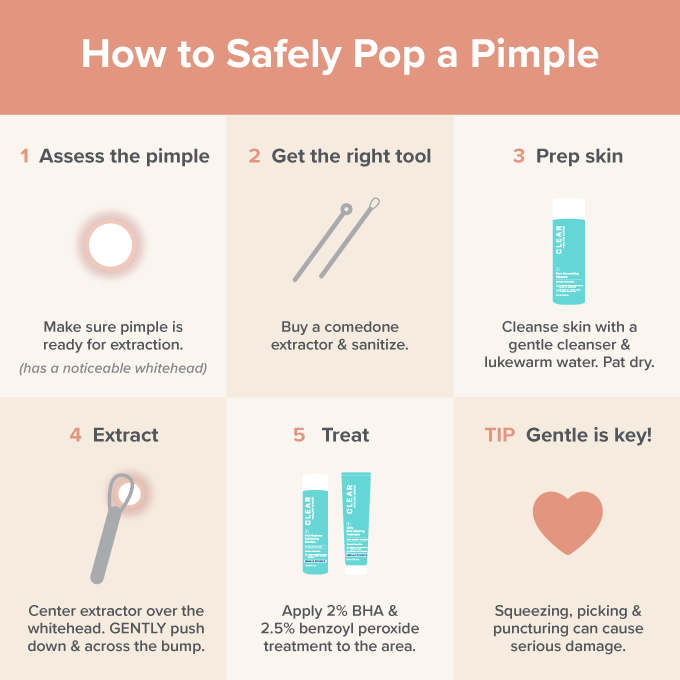The Allure and the Danger: A Deep Dive into Pimple Popping
We’ve all been there. That satisfying pop of a stubborn blackhead, a moment captured countless times on the internet. But the seemingly simple act of squeezing a pimple holds significant risks, and dermatologists overwhelmingly advise against it. This blog post explores the temptation, the dangers, and the safer alternatives for dealing with those pesky blemishes.
When to Absolutely Resist the Urge
Before we even consider the “how-to,” let’s establish the crucial “when-not-to.” Attempting DIY extractions can quickly escalate into a skincare nightmare. Absolutely avoid popping a pimple if:
The Pimple is Deep, Painful, or Cystic:
These are often signs of a deeper infection. Forcing them could lead to significant inflammation, scarring, and potentially even spread the infection. Leave these to the professionals.
The Pimple Isn’t Ready:

A pimple needs a visible whitehead or blackhead—a “ripe” blemish, if you will. Squeezing a blemish without a visible head simply pushes the bacteria deeper into your skin, potentially worsening the situation.
Your Tools and Hands Aren’t Clean:

This is paramount. Introducing bacteria to an open wound will almost certainly lead to infection and scarring. Sterility is non-negotiable.
The Risky Business of DIY Pimple Extraction
While tempting, home pimple popping carries significant consequences:
Scarring:
Improper extraction can damage delicate skin tissue, leaving behind permanent marks. This is especially true for aggressive squeezing or using unclean tools.
Infection:
Open wounds are susceptible to bacterial infection. Unclean hands or tools easily introduce harmful bacteria, potentially leading to painful and protracted infections.
Worsening Acne:
Instead of resolving the problem, squeezing pushes the contents of the pimple deeper, leading to increased inflammation, more breakouts, and potentially even spreading bacteria to neighboring pores.
Spread of Bacteria:
Touching your face frequently, especially after squeezing a pimple, spreads bacteria, potentially triggering new breakouts.
If You *Must* Pop (Proceed with Extreme Caution!)
If, despite the warnings, you feel compelled to attempt extraction, follow these steps meticulously. Remember: this is a last resort, and even with careful technique, you’re still risking damage.
Preparation is Key:
- Cleanse: Begin with a thorough cleanse using warm water and a gentle facial cleanser.
- Steam (Optional): Gently steaming your face for 5-10 minutes can help open pores, making extraction slightly easier.
- Sterilize Everything: Thoroughly sanitize your hands, nails, and any tools (like a comedone extractor) with rubbing alcohol. Consider using gloves for added protection.
The Extraction Process:
- Gentle Pressure: Apply gentle, even pressure around the pimple or blackhead. Do not dig or force the blemish.
- Comedone Extractor (Optional): If using a comedone extractor, use gentle pressure around the pore’s opening. Never force it.
- Stop If It’s Difficult: If the contents don’t emerge easily, stop immediately. Forcing it will only cause damage.
Post-Extraction Care:
- Cleanse Again: Cleanse the area with an antiseptic toner or solution.
- Spot Treatment: Apply a spot treatment containing salicylic acid, benzoyl peroxide, or a clay mask to help soothe the skin and prevent further breakouts.
- Leave It Alone: Resist the urge to touch or pick at the area.
When to Seek Professional Help
Certain situations demand professional intervention. Consult a dermatologist or licensed esthetician if:
- You have recurrent or painful acne, cysts, or large blackheads.
- You’re prone to scarring or dark spots.
- You want a safer, more thorough extraction using professional tools and techniques (e.g., high-frequency wands, dermaplaning).
Aftercare and Professional Treatments
Supporting your skin’s healing process is crucial. Consider using products like salicylic acid (exfoliates), benzoyl peroxide (fights bacteria), and hydrocolloid patches (protect and promote healing). For persistent or severe acne, professional treatments like acne extractions, corticosteroid injections, or prescription medications may be necessary.
The Bottom Line: Prevention and Professionalism
While the allure of immediate gratification is strong, the risks of DIY pimple popping significantly outweigh the benefits. Prioritize prevention through good skincare, and when blemishes arise, consider professional help. Your skin will thank you.







